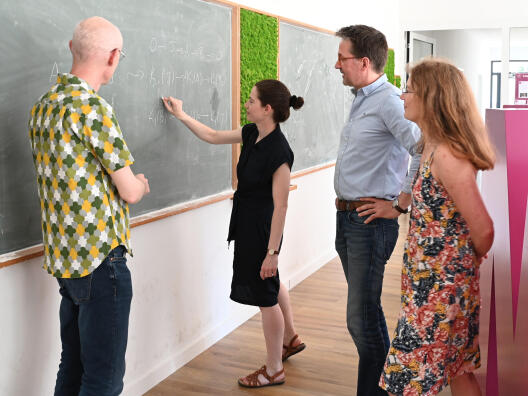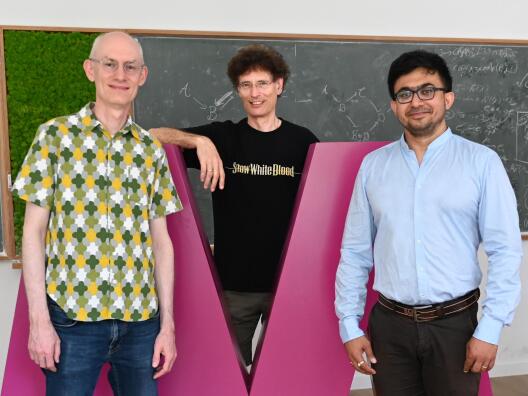since 2023
$\bullet $ Christopher Deninger, Theo Grundhöfer, and Linus Kramer.
Weil tensors, strongly regular graphs, multiplicative characters, and a quadratic matrix equation.
J. Algebra, 656:170–195, October 2024.
doi:10.1016/j.jalgebra.2023.08.028.
$\bullet $ Philipp Sibbel and Wilhelm Winter.
A Cantor spectrum diagonal in O$_2$.
arXiv e-prints, September 2024.
arXiv:2409.03511.
$\bullet $ Shirly Geffen and Julian Kranz.
Note on C*-algebras associated to boundary actions of hyperbolic 3-manifold groups.
arXiv e-prints, July 2024.
arXiv:2407.15215.
$\bullet $ Christoph Böhm and Urs Hartl.
Moment map flow on real reductive Lie groups and GIT estimates.
arXiv e-prints, June 2024.
arXiv:2406.19340.
$\bullet $ Eusebio Gardella, Shirly Geffen, Rafaela Gesing, Grigoris Kopsacheilis, and Petr Naryshkin.
Essential freeness, allostery and Z-stability of crossed products.
arXiv e-prints, May 2024.
arXiv:2405.04343.
$\bullet $ Eusebio Gardella, Shirly Geffen, Julian Kranz, Petr Naryshkin, and Andrea Vaccaro.
Tracially amenable actions and purely infinite crossed products.
Mathematische Annalen, March 2024.
doi:10.1007/s00208-024-02833-9.
$\bullet $ Eusebio Gardella, Shirly Geffen, Petr Naryshkin, and Andrea Vaccaro.
Dynamical comparison and Z-stability for crossed products of simple $\rm C^*$-algebras.
Advances in Mathematics, 438:109471, February 2024.
doi:10.1016/j.aim.2023.109471.
$\bullet $ Marco Amelio, Simon André, and Katrin Tent.
Non-split sharply 2-transitive groups of odd positive characteristic.
arXiv e-prints, December 2023.
arXiv:2312.16992.
$\bullet $ Kristin Courtney and Wilhelm Winter.
Images of order zero maps.
arXiv e-prints, December 2023.
arXiv:2312.08215.
$\bullet $ Corina Ciobotaru, Linus Kramer, and Petra Schwer.
Polyhedral compactifications, I.
Advances in Geometry, 23(3):413–436, August 2023.
doi:10.1515/advgeom-2023-0018.
$\bullet $ Simon André and Katrin Tent.
Simple sharply 2-transitive groups.
Transactions of the American Mathematical Society, 376(06):3965–3993, June 2023.
doi:10.1090/tran/8846.
$\bullet $ Christopher Deninger and Michael Wibmer.
On the proalgebraic fundamental group of topological spaces and amalgamated products of affine group schemes.
arXiv e-prints, June 2023.
arXiv:2306.03296.
$\bullet $ Eugen Hellmann.
On the derived category of the Iwahori–Hecke algebra.
Compositio Mathematica, 159(5):1042–1110, May 2023.
doi:10.1112/S0010437X23007145.
$\bullet $ Shirly Geffen and Dan Ursu.
Simplicity of crossed products by FC-hypercentral groups.
arXiv e-prints, April 2023.
arXiv:2304.07852.
$\bullet $ Konstantin Ardakov and Peter Schneider.
Stability in the category of smooth mod-$p$ representations of $\mathrm S \mathrm L_2(\mathbb Q_p)$.
arXiv e-prints, April 2023.
arXiv:2304.02585.
$\bullet $ Kristin Courtney and Wilhelm Winter.
Nuclearity and CPC$^*$-systems.
arXiv e-prints, April 2023.
arXiv:2304.01332.
$\bullet $ Eusebio Gardella, Shirly Geffen, Julian Kranz, and Petr Naryshkin.
Classifiability of crossed products by nonamenable groups.
J. Reine Angew. Math., 797(4565952):285–312, March 2023.
doi:10.1515/crelle-2023-0012.
$\bullet $ Chiranjib Mukherjee and Konstantin Recke.
Haagerup property and group-invariant percolation.
arXiv e-prints, March 2023.
arXiv:2303.17429.
$\bullet $ Kang Li, Hung-Chang Liao, and Wilhelm Winter.
The diagonal dimension of sub-$\mathrm C^*$-algebras.
arXiv e-prints, March 2023.
arXiv:2303.16762.
$\bullet $ Michael Wiemeler.
On circle actions with exactly three fixed points.
arXiv e-prints, March 2023.
arXiv:2303.15396.
$\bullet $ Christoph Böhm and Ramiro A. Lafuente.
Non-compact Einstein manifolds with symmetry.
J. Amer. Math. Soc., 36(3):591–651, February 2023.
doi:10.1090/jams/1022.
$\bullet $ Linus Kramer and Markus J. Stroppel.
Hodge operators and exceptional isomorphisms between unitary groups.
Journal of Lie Theory, 33(1):329–360, January 2023.
URL: www.heldermann.de/JLT/JLT33/JLT331/jlt33015.htm.
Back to top
further publications




